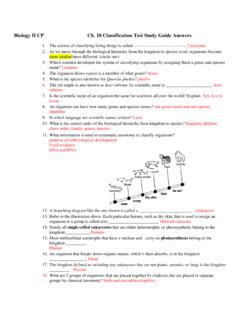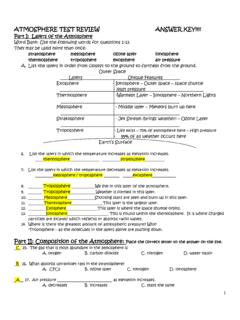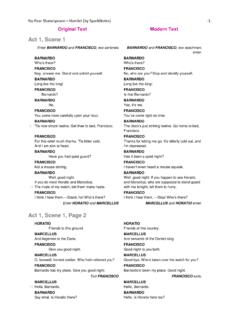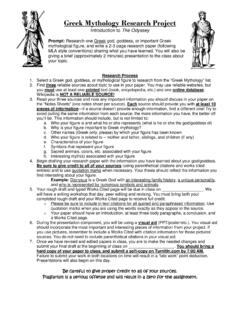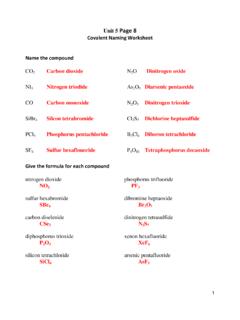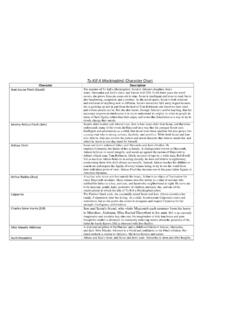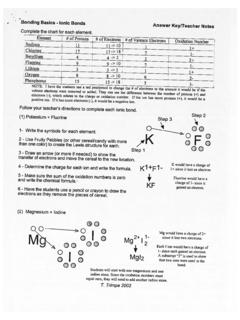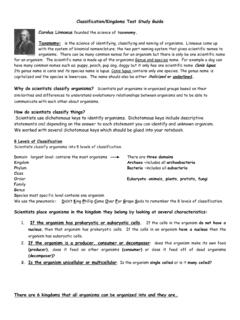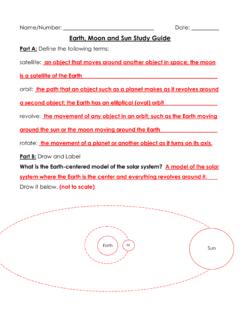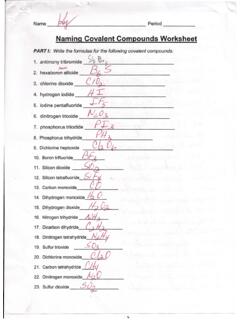Transcription of Naming Compounds Practice Worksheet
1 Name _____ Date_____ Block ___ Naming Compounds Test Review Practice Name the following ionic Compounds : 1) NH4Cl _____ 2) Fe(NO3)3 _____ 3) TiBr3 _____ 4) Cu3P _____ 5) SnSe2 _____ 6) GaAs _____ 7) Pb(SO4)2 _____ 8) Be(HCO3)2 _____ 9) Mn2(SO3)3 _____ 10) Al(CN)3 _____ Write the formulas for the following Compounds : 11) chromium (VI) phosphate _____ 12) vanadium (IV) carbonate _____ 13) tin (II) nitrite _____ 14) cobalt (III) oxide _____ 15) titanium (II) acetate _____ 16) vanadium (V) sulfide _____ 17) chromium (III) hydroxide _____ 18) lithium iodide_____ 19) lead (II) nitride _____ 20) silver bromide _____ 21) NaBr _____ 22) Sc(OH)3 _____ 23) V2(SO4)3 _____ 24) NH4F _____ 25) CaCO3 _____ 26) NiPO4 _____ 27) Li2SO3 _____ 28) Zn3P2 _____ 29) Sr(C2H3O2)2 _____ 30) Cu2O _____ 31) Ag3PO4 _____ Name _____ Date_____ Block ___ 32) YClO3 _____ 33)
2 SnS2 _____ 34) Ti(CN)4 _____ 35) KMnO4 _____ 36) Pb3N2 _____ 37) CoCO3 _____ 38) CdSO3 _____ 39) Cu(NO2)2 _____ 40) Fe(HCO3)2 _____ Write the formulas for the following ionic Compounds : 41) lithium acetate _____ 42) iron (II) phosphate _____ 43) titanium (II) selenide _____ 44) calcium bromide _____ 45) gallium chloride _____ 46) sodium hydride _____ 47) beryllium hydroxide _____ 48) zinc carbonate _____ 49) manganese (VII) arsenide _____ 50) copper (II) chlorate _____ 51) cobalt (III) chromate _____ 52) ammonium oxide _____ 53) potassium hydroxide _____ 54) lead (IV) sulfate _____ 55) silver cyanide _____ 56) vanadium (V) nitride _____ 57) strontium acetate _____ 58) molybdenum sulfate _____ 59) platinum (II)
3 Sulfide _____ 60) ammonium sulfate _____ 61) NaBr _____ 62) Ca(C2H3O2)2 _____ 63) P2O5 _____ 64) Ti(SO4)2 _____ 65) FePO4 _____ Name _____ Date_____ Block ___ 66) K3N _____ 67) SO2 _____ 68) CuOH _____ 69) Zn(NO2)2 _____ 70) V2S3 _____ Write the formulas for the following chemical Compounds : 71) silicon dioxide _____ 72) nickel (III) sulfide _____ 73) manganese (II) phosphate _____ 74) silver acetate _____ 75) diboron tetrabromide _____ 76) magnesium sulfate heptahydrate _____ 77) potassium carbonate _____ 78) ammonium oxide _____ 79) tin (IV) selenide _____ 80) carbon tetrachloride _____ MULTIPLE CHOICE.
4 Choose the one alternative that best completes the statement or answers the question. 81) Which of the following pairs of elements would most likely form a ionic compound ? A) Ca and Ni B) Cu and Ar C) F and S D) Zn and K E) Na and Cl 82) Electronegativity is a concept that is useful along with other concepts in _____. A) deciding how many electrons are involved in bonding B) deciding if double bonds are present in a molecule C) formulating a statement of the octet rule D) determining the number of single bonds present in a molecule E) predicting the polarity of a bond 83) Which statement about electronegativity is incorrect?
5 A) Within a periodic table group, electronegativity increases from bottom to top. B) Metals generally have higher electronegativity values than nonmetals. C) Within a periodic table row, electronegativity increases from left to right. D) Fluorine is the most electronegative atom of all the elements. Name _____ Date_____ Block ___ 84) Which of the following pairs is incorrectly matched? formula bond type A) CuO ionic B) BBr3 nonpolar covalent C) CCl4 polar covalent D) KCl ionic E) IF nonpolar covalent 1 85) Which of the following pairs is incorrectly matched?
6 Formula bond type A) MgO ionic B) CoS ionic C) CH4 polar covalent D) NF3 polar covalent E) N2 nonpolar covalent 87) Elements in groups IIA and VA of the periodic table possess, respectively, how many valence electrons? A) 2 and 6 B) 2 and 2 C) 6 and 2 D) 3 and 4 E) 2 and 5 88) Which of the following statements about the noble gases is incorrect? A) All have very stable electron arrangements. B) They are the most reactive of all gases. C) All have 8 valence electrons. D) All exist in nature as individual atoms rather than molecular form.
7 89) Which of the following statements concerning double covalent bonds is correct? A) They always involve the sharing of 2 electron pairs. B) They are found only in molecules containing polyatomic ions. C) They occur only between atoms containing 4 valence electrons. D) They are found only in molecules containing S. Name the following acids and bases: 90) NaOH _____ 91) H2SO3 _____ 92) H2S _____ 93) H3P _____ 94) H3PO4 _____ 95) NH3 _____ 96) HCN _____ 97) Ca(OH)2 _____ 98) Fe(OH)3 _____ Write the formulas of the following acids and bases.
8 Name _____ Date_____ Block ___ 99) hydrobromic acid _____ 100) hydrofluoric acid _____ 101) carbonic acid _____ 102) lithium hydroxide _____ 103) nitrous acid _____ 104) cobalt (II) hydroxide _____ 105) sulfuric acid _____ 106) beryllium hydroxide _____ Name _____ Date_____ Block ___ Solutions for the Naming Ionic Compounds Practice Worksheet 1) ammonium chloride 2) iron (III) nitrate 3) titanium (III) bromide 4) copper (I) phosphide 5) tin (IV) selenide 6) gallium arsenide 7) lead (IV) sulfate 8) beryllium bicarbonate 9) manganese (III) sulfite 10) aluminum cyanide 11) Cr(PO4)2 12) V(CO3)2 13) Sn(NO2)2 14) Co2O3 15) Ti(C2H3O2)2 16) V2S5 17) Cr(OH)3 18) LiI 19) Pb3N2 20) AgBr 21) NaBr sodium bromide 22) Sc(OH)3 scandium (III) hydroxide 23) V2(SO4)3 vanadium (III) sulfate 24) NH4F ammonium fluoride 25) CaCO3 calcium carbonate 26) NiPO4 nickel (III) phosphate 27) Li2SO3 lithium sulfite 28) Zn3P2 zinc phosphide 29) Sr(C2H3O2)2 strontium acetate 30) Cu2O copper (I) oxide 31) Ag3PO4 silver phosphate 32) YClO3 yttrium (I)
9 Chlorate 33) SnS2 tin (IV) sulfide 34) Ti(CN)4 titanium (IV) cyanide 35) KMnO4 potassium permanganate 36) Pb3N2 lead (II) nitride 37) CoCO3 cobalt (II) carbonate 38) CdSO3 cadmium sulfite 39) Cu(NO2)2 copper (II) nitrite 40) Fe(HCO3)2 iron (II) bicarbonate Name the following chemical Compounds : 41) lithium acetate LiC2H3O2 42) iron (II) phosphate Fe3(PO4)2 43) titanium (II) selenide TiSe Name _____ Date_____ Block ___ 44) calcium bromide CaBr2 45) gallium (III) chloride GaCl3 46) sodium hydride NaH 47) beryllium hydroxide Be(OH)2 48) zinc carbonate ZnCO3 49) manganese (VII) arsenide Mn3As7 50) copper (II) chlorate Cu(ClO3)2 51) cobalt (III) chromate Co2(CrO4)3 52) ammonium oxide (NH4)2O 33) potassium hydroxide KOH 54) lead (IV) sulfate Pb(SO4)2 55) silver cyanide AgCN 56) vanadium (V) nitride V3N5 57)
10 Strontium acetate Sr(C2H3O2)2 58) molybdenum (VI) sulfate Mo(SO4)3 59) platinum (II) sulfide PtS 60) ammonium sulfate (NH4)2SO4 61) NaBr sodium bromide 62) Ca(C2H3O2)2 calcium acetate 63) P2O5 diphosphorus pentoxide 64) Ti(SO4)2 titanium(IV) sulfate 65) FePO4 iron (III) phosphate 66) K3N potassium nitride 67) SO2 sulfur dioxide 68) CuOH copper (I) hydroxide 69) Zn(NO2)2 zinc nitrite 70) V2S3 vanadium (III) sulfide Write the formulas for the following chemical Compounds : 71) silicon dioxide SiO2 72) nickel (III) sulfide Ni2S3 73) manganese (II) phosphate Mn3(PO4)2 74) silver acetate AgC2H3O2 75) diboron tetrabromide B2Br4 76) magnesium sulfate heptahydrate 77) potassium carbonate K2CO3 78) ammonium oxide (NH4)2O 79) tin (IV) selenide SnSe2 80) carbon tetrachloride CCl4 81) Which of the following pairs of elements would most likely form a ionic compound ?
